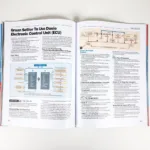Portable car diagnostic scanners have revolutionized the way we troubleshoot and maintain vehicles. From empowering DIY enthusiasts to equipping professional mechanics, these compact devices offer a window into your car’s electronic control unit (ECU), providing invaluable insights into its health and performance. Understanding the capabilities and benefits of these tools is crucial in today’s automotive landscape. Let’s dive into the world of portable car diagnostic scanners and explore how they can benefit you. Learn how to use car diagnostics machine through our comprehensive guide.
Why Choose a Portable Car Diagnostic Scanner?
A portable car diagnostic scanner is more than just a gadget; it’s an investment in your vehicle’s well-being. These handy tools offer a range of benefits, from identifying minor issues before they escalate into costly repairs to providing peace of mind on the road. They empower you to take control of your car’s maintenance, saving you time and money in the long run.
- Early Problem Detection: Catch potential problems early, preventing expensive repairs down the road.
- Cost Savings: Reduce diagnostic fees by identifying issues yourself.
- Enhanced Control: Gain a deeper understanding of your vehicle’s performance.
- Convenience: Diagnose issues anytime, anywhere.
- Peace of Mind: Be prepared for unexpected breakdowns and identify issues quickly.
Imagine this: your check engine light illuminates unexpectedly. Instead of rushing to a mechanic and incurring diagnostic fees, you can quickly connect your portable car diagnostic scanner and pinpoint the problem. This not only saves you money but also provides valuable information you can share with your mechanic, streamlining the repair process.
Types of Portable Car Diagnostic Scanners
The market offers a wide array of portable car diagnostic scanners, each catering to different needs and budgets. Choosing the right one depends on your technical expertise and the depth of information you require. Here’s a breakdown of the common types:
Basic Code Readers
These entry-level scanners are ideal for DIY enthusiasts seeking to read and clear basic diagnostic trouble codes (DTCs). They provide a simple and affordable way to identify common issues.
OBD-II Scanners
Offering more advanced features than basic code readers, OBD-II scanners can access live data streams from various sensors, providing real-time insights into your car’s performance.
Professional-Grade Scanners
Designed for professional mechanics and advanced users, these scanners offer comprehensive diagnostic capabilities, including bidirectional control, allowing you to perform tests and activate components.
Which type of scanner suits your needs best depends on your level of technical expertise and the tasks you intend to perform. A DIY enthusiast may find a basic code reader sufficient, while a professional mechanic would require the advanced features of a professional-grade scanner. Check out our guide on a universal diagnostic tool for all cars for more information.
Key Features to Consider
When choosing a portable car diagnostic scanner, certain key features can significantly impact its usability and effectiveness. Consider the following factors:
- Compatibility: Ensure the scanner is compatible with your vehicle’s make and model.
- User Interface: Opt for a scanner with an intuitive and easy-to-navigate interface.
- Data Logging: The ability to log data is essential for tracking performance trends over time.
- Live Data Streaming: Real-time data streaming provides valuable insights into sensor readings.
- Update Capabilities: Regular updates ensure the scanner stays current with the latest vehicle technologies.
How to Use a Portable Car Diagnostic Scanner
Using a portable car diagnostic scanner is generally straightforward. Locate your car’s OBD-II port, typically located under the dashboard on the driver’s side. Connect the scanner, turn on the ignition, and follow the on-screen prompts to read and interpret the diagnostic codes. Learn more about a universal all car vehicle diagnostic machine.
Conclusion
Investing in a portable car diagnostic scanner is a wise decision for any car owner. These powerful tools offer a range of benefits, from early problem detection and cost savings to enhanced control and peace of mind. By understanding the different types of portable car diagnostic scanners and their key features, you can choose the right one for your needs and embark on a journey of empowered car maintenance. If you’re located in Malaysia, explore our options for a car diagnostic scanner malaysia. If you need a diagnostic machine for DPF issues across various car models, check our page on diagnostic machine dpf all cars.
FAQ
- What is a DTC? A Diagnostic Trouble Code (DTC) is a code stored by the vehicle’s onboard computer system to indicate a specific malfunction.
- Where is the OBD-II port located? Typically, the OBD-II port is located under the dashboard on the driver’s side.
- Do all cars have an OBD-II port? Most cars manufactured after 1996 have an OBD-II port.
- Can I clear DTCs with a portable scanner? Yes, most portable scanners allow you to clear DTCs after addressing the underlying issue.
- How often should I use a diagnostic scanner? You can use it whenever your check engine light illuminates or if you suspect a problem.
Situations You Might Encounter
- Intermittent Check Engine Light: A portable scanner can help pinpoint the issue even if the light is not constantly on.
- Poor Fuel Economy: The scanner can help identify potential problems affecting fuel efficiency.
- Rough Idling: Diagnose the cause of rough idling by checking sensor data.
Further Exploration
- Explore our guide on how to choose the right scanner for your needs.
- Learn about advanced diagnostic techniques.
Contact us via WhatsApp: +1(641)206-8880 or Email: cardiagtechworkshop@gmail.com for 24/7 support.

